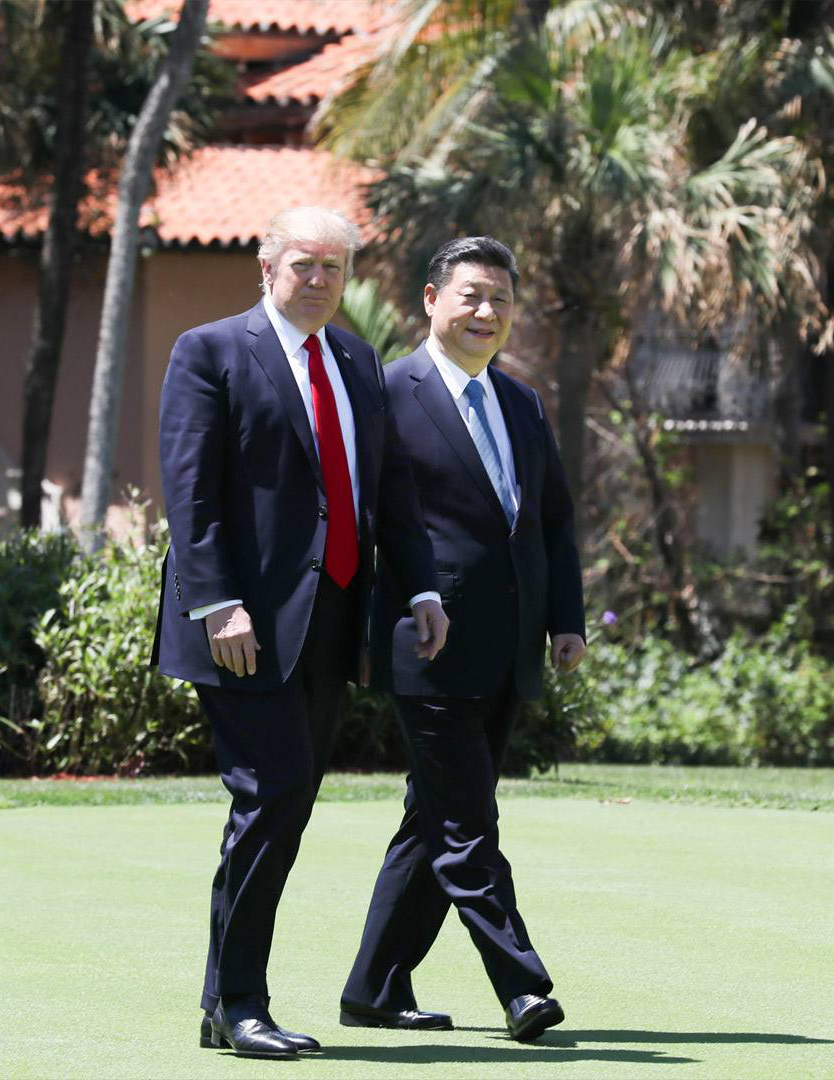Xi-Trump summit set positive tone for future ties: Analysts

Chinese President Xi Jinping and US President Donald Trump walk at the Mar-a-Lago resort in Florida on April 7 local time.
Scholars said the recent meeting between Chinese President Xi Jinping and US President Donald Trump has set a tone of cooperation between the two nations.
The leaders of the world’s two largest economies held face-to-face talks for the first time at the Mar-a-Lago resort in Florida from April 6 to 7.
Tao Wenzhao, Honorary Member of the Chinese Academy of Social Sciences (CASS) and former deputy director of the Institute of American Studies at CASS, described the landmark meeting as an end to the transitional stage and the first step to planning a new relationship.
Trump has been in office for less than 100 days, so his China policy has yet to take shape, Tao noted. The meeting, which aimed to settle the strategic framework of China-US relations, has significantly reduced uncertainties about bilateral ties brought by the change of administrations, Tao said.
“The meeting marks a smooth connection between the Chinese government and the new US administration,” said Wu Xinbo, director of the Center for American Studies at Fudan University.
Though China and the United States have major disagreements on some issues, they are not irreconcilable and can be gradually resolved through dialogue and cooperation, said Li Haidong, a professor of international relations at China Foreign Affairs University.
The meeting is significant in the way that “it sent the overarching message that the two sides will heal the divide through cooperation,” Li said.
During the meeting, four high-level dialogues and cooperation mechanisms were established in terms of diplomacy, economy, law enforcement, cyber-security as well as cultural and people-to-people exchanges. And the mechanisms of diplomacy and economy have been started, with the mode of operation and work priorities discussed.
Li said the establishment of the four mechanisms is a concrete manifestation of the smooth transition of China-US relations after the election.
Citing doubts about previous dialogue and communication mechanisms between China and the United States, Wu said the four new mechanisms generally preserve and adjust previous dialogue channels, providing an “institutional guarantee” for the development of the relationship in the new age.
Lower only than the leaders’ summit, the four mechanisms include all aspects of the China-US relationship and cover a wider range than before, Tao said.
The mechanism of diplomacy security is a highlight that will definitely add much more weight to security exchanges in bilateral relations, Tao said, adding that it will help bring about a more balanced, solid relationship.
“The meaning of building a China-US relationship without conflict and confrontation can never be emphasized enough,” he said.
Economic and trade cooperation is always regarded as the “ballast” for stabilizing bilateral relations. Since Trump took office, economic and trade matters have again come to the fore, so this was a focal topic at the meeting.
Li said that the meeting, which lasted only a few hours, is unlikely to address specific issues in bilateral economic and trade relations, but the tone of cooperation was set.
Scholars said that a trade war is by no means an option for Trump to deal with the trade imbalance that he often lamented during his campaign. In a September 2016 report, the Peterson Institute for International Economics (PIIE) examined three “what if” scenarios regarding a potential China-US trade war. According to the report, whether a full, asymmetrical or aborted trade war occurred, large shocks would reverberate through the US economy. In the full trade war scenario, the US economy would be pushed into recession in 2019.
Mutual benefit is the fundamental reason why China-US trade jumped from more than $2 billion—the level when the two nations established diplomatic relations in 1979—to more than $100 billion today. Tao said that the US deficit with China does not mean that the United States is a “loser” in trade.
Cheap and fine Chinese products have helped each US household to save nearly $1,000 on average every year. Currently, China’s direct investment in the United States has exceeded US investment in China, creating a multitude of job opportunities for America, Tao said.
Wu noted that the two sides should handle trade imbalance based on the principle of equality and mutual benefit. “The United States cannot unilaterally demand China solve problems arising in exports to America and open the market,” Wu said, “It should likewise make adjustments accordingly, such as loosening restrictions on the export of non-military technological products to China, therefore providing a better environment for Chinese enterprises to invest in the United States.”
To promote a more balanced, closer China-US relationship, it is important to solve problems, but expanding the scope of cooperation matters even more, scholars said.
According to a report released by the Center for China and Globalization on April 5, cooperation in infrastructure construction is expected to become a new highlight of China-US cooperation.
Infrastructure investment is a key measure in Trump’s blueprint to reinvigorate the US economy. In late 2016, he announced a plan to invest $1 trillion in infrastructure spending over the next 10 years. Yet China’s infrastructure investment totaled approximately $1.4 trillion in the first 10 months of 2016. In other words, China accomplished Trump’s 10-year infrastructure plan within less than a year, which fully indicates China’s comparative advantages in capital, technology and experience regarding infrastructure construction.
According to the report, if China-US infrastructure cooperation can create jobs for the United States and revive the local economy, the specter of a trade war between the two countries will disappear.
Mao Li is a reporter at the Chinese Social Sciences Today.
